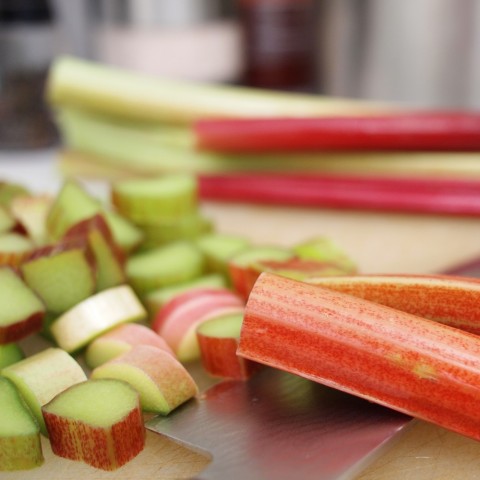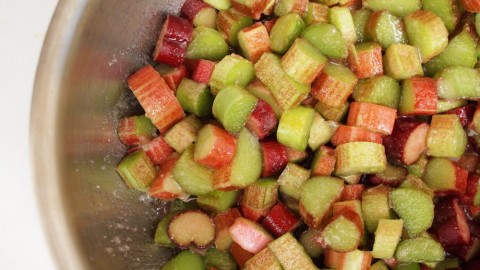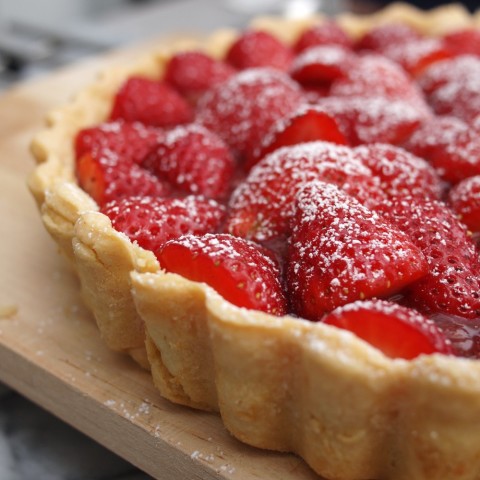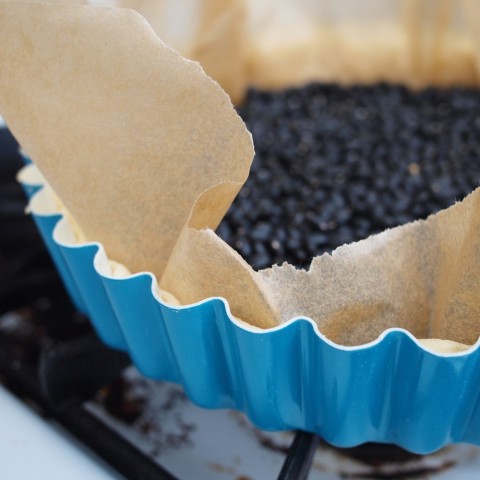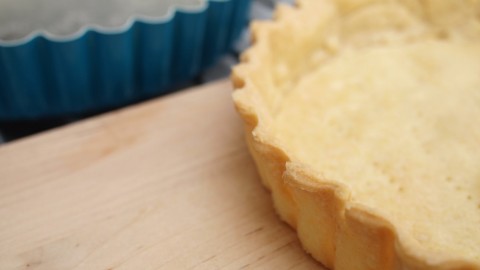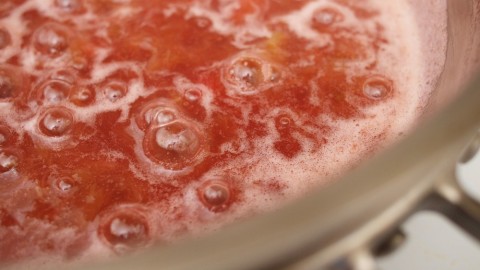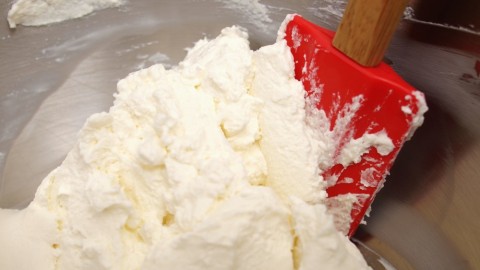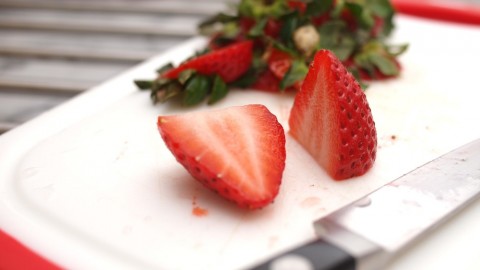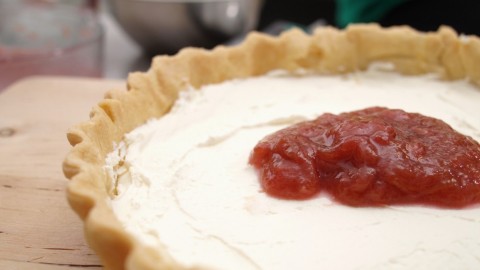Strawberries and rhubarb are a classic combination. They’re sweet and sour, bright and luxurious, irresistible as dessert, or as jam, or in just about any other context that I can rattle off. David Lebovitz recently extolled their virtue, cooked together with sweet wine and honey, as a compote.* And in the rhubarb entry of The Flavor Bible, Karen Page and Andrew Dornenburg place strawberries in bold caps with an asterisk, signifying that this is one of those “Holy Grail” pairings that are the most highly recommended by the greatest number of experts.
But then, you don’t need some fancy book to tell you that. One needs only look at the critical mass of strawberry-rhubarb pie recipes out there (a quick Google search yields more than four million results) to figure out that this is one of the most beloved flavor combinations in world cuisine. Ask your grandmother. Or your neighbors. Or your local farmer. They all know what’s what.
But strawberry-rhubarb pie has a problem. It’s kind of a gross and gloopy problem, and it’s the reason why I rarely make it, despite the fact that I love the two together. The issue is that both strawberries and rhubarb produce a lot of liquid when cooked — especially when they’re cooked with sugar. The acidity of the rhubarb makes pie-filling thickeners like cornstarch considerably less effective. And the result, as often as not, is a soggy-bottomed pie that you might be better served to drink.
There are solutions out there. Specialty products like ClearJel, I am given to understand, are less prone to lose effectiveness in acidic environments. But I’ve never really gotten the hang of ClearJel. And besides, if cornstarch already seems a little bit like a weird processed food to me, modified cornstarch, which is what ClearJel claims to be, is particularly strange. Modified how?
Which brings me to this week’s experiment. This recipe tries to answer the question: how can you go about making a strawberry-rhubarb pie that’s not that strawberry-rhubarb pie? How can you get the flavor combination without the gloop?
The answer — or at least, the answer that I came up with this time — is to abandon the notion of cooking the two fruits (yes, rhubarb is legally a fruit) together, and instead, turn that pie into a layered tart. This one is a three-layered tart, to be exact. It starts with a base of sweetened mascarpone cheese, to act both as a source of richness and a sealant, keeping the moisture of the fruit away from the bottom of the crust. On top of that, there’s a nice thick layer of rhubarb compote. And onto that, fresh, ripe strawberries.
It’s not traditional. I’ll give you that. It’s not your grandmother’s strawberry-rhubarb pie. But then, its filling doesn’t run out of the crust, off your plate, and dribble onto your pants as you try to eat it, either. So perhaps we can call that progress.
And besides, this tart has the Elizabeth seal of approval. It served as dessert one night during her recent visit, and about halfway through her slice, she half asked and half exclaimed: why don’t more people leave off cooking their strawberries?
I’d be hard pressed to think of higher praise than that.
So I’d recommend that you all abandon your preconceived notions of what a strawberry-rhubarb pastry “should” look like, and try this one instead. And do it soon. The window during which both fruits are in season, at least on the East Coast, is perilously narrow. And it’s already starting to close.
1 batch Shortcrust Pastry, made with white flour, cream, and egg yolk
1 batch Rhubarb Compote, made according to the instructions here
1 quart Strawberries (small, local ones are better than large, tasteless ones)
12 oz Mascarpone Cheese
2 tbsp Heavy Cream
2 tbsp Granulated Sugar
Juice of One Lemon
Powdered Sugar
For the crust: preheat your oven to 400F. Roll out your batch of shortcrust and lay it snugly into a tart pan, trimming any excess by taking a rolling pin to the edges. Perforate the bottom of the crust with a fork, and refrigerate for about 40 minutes.
At the end of that time, line your crust with parchment paper, fill it with dried beans, rice, or ceramic pie weights, and blind bake for 20 minutes. Then remove from the oven, remove the parchment and the weights, and return to the oven to bake for 20 minutes more.
When the crust is done, set it aside and allow it to cool before removing it from the tart pan onto an appropriate platter (I actually used a wooden cutting board to make my tart).
For the compote: To make the rhubarb compote, follow the instructions posted *here*. Be sure to allow the compote to chill thoroughly before using.
For the mascarpone filling: To the work bowl of a stand mixer (or just to a medium-sized bowl), add the mascarpone cheese, cream, granulated sugar, and lemon juice. Whisk vigorously to combine the ingredients, and then keep on whisking until the mixture begins to look just a bit fluffy — 2-3 minutes in the Kitchenaid. Refrigerate until you’re ready to use it.
Putting it all together: Thoroughly wash your quart of strawberries, then core them and slice them in half, being careful to keep them looking pretty, and trying your best to trim them to an even size.
Into the bottom of the tart crust, add the mascarpone filling, about a third at a time, spreading it evenly over the bottom with a spatula (an offset spatula would be great for this job). You want the cheese to form a lush — but not thick — layer on the bottom. Depending on the surface area of your crust, you may not need all of it.
On top of the mascarpone, add the rhubarb compote a couple of tablespoons at a time. Again: you want to spread it evenly with a spatula. Again, you want it to be lush, but not thick. And again: you will likely not need all of it.
Finally, on top of the compote, carefully place the strawberries to form a pleasing pattern. I like to place one ring, inward-facing around the edge, and then fill in the interior of the tart however I can to minimize the space between pieces of fruit. It’s okay if your strawberry placement is not perfect; and it’s okay if you have to overlap them a little bit to get them close enough together.
Dust the finished tart liberally with powdered sugar (it will dissolve almost immediately, creating a nice sheen), slice into eight even pieces, and serve as soon as possible with a dollop of homemade whipped cream.
Enjoy!
* Lebovitz posted his rhubarb compote not too long after I posted mine. I think I’d be more inclined to be territorial about it if his didn’t look so delicious.
